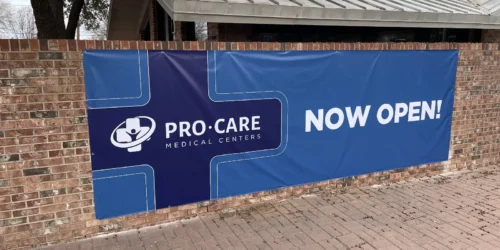Broken bones can be frustrating and not to mention painful no matter where they are! It is important to have a fracture treated quickly in order to get you back to your daily routine quickly. However, sometimes you may not even know you have a fracture! We’ve compiled some tips and tricks for broken bones below. At Pro-Care, our team is here from diagnosis and through your entire healing process.
Common Bone Fracture Symptoms & Causes

You should seek prompt medical treatment as soon as you suspect a fracture. If you have suffered an injury that could result in a fracture, it is better to have a thorough evaluation quickly. The most common causes of fractures are:
- Trauma/Force – While bones are strong, excessive force will cause them to break. This can be the force of a car accident or even a fall from a step stool.
- Osteoporosis – The natural demineralization of the bones found in osteoporotic patients causes weakness and results in frequent fractures.
- Overuse – Repetitive use can cause muscles to weaken and lead to joint instability. This can result in fractures or dislocations. You can also find overuse or ‘stress’ fractures in the shins of runners who are maybe overtraining.
While some symptoms of a fracture can be rather obvious, others are less apparent. There are five common symptoms to be on the lookout for when suspecting a fracture.
- Bruising – When soft tissues suffer a trauma, they can begin to bleed beneath the skin. This appears as bruising, usually a purple and blue-tinged spot, tender to the touch.
- Intense Pain
- Swelling – After a fracture occurs, blood rushes to the fracture. This can result in minor or even severe swelling.
- Deformity – For obvious fractures, you will see a deformity in the limb. Open fractures are fractures in which the bone protrudes through the skin.
- Crepitus – A sign of a fracture you may not be aware of is known as crepitus. Crepitus is the crunchy feeling of a bone or joint. The feeling and sometimes the sound is caused by bone and ligament fragments grinding together.
If you suspect a fracture, you should seek medical care quickly. Even a mild fracture requires medical attention in order to heal correctly. Quick treatment will help facilitate a speedy recovery. Emergency treatment is needed for bleeding, open fractures, and unconsciousness.
How To Diagnose Fractures

The initial step in diagnosing a fracture is a thorough physical exam. This can reveal deformities, tenderness, and even swelling. In order to confirm a fracture is present, your physician will order diagnostic imaging.
- X-rays – An x-ray is the most common diagnostic image for a broken bone. X-rays show calcified structures, like bones, so your doctor can identify any damage.
- MRI – An MRI, or magnetic resonance image, can be used to identify fractures, but more commonly, any associated soft tissue damage.
- CT Scan – Short for computed tomography, a CT scan is a combination of MRI and X-ray, providing a highly detailed picture of the affected area.
After you know you have a broken bone, there are several different treatment methods, including at-home, surgical, chiropractic care, and the well-known plaster cast. After you have diagnostic imaging done, your team at Pro-Care will work with you to determine the best course of treatment for your fractured bone.
- Traditional Cast – A traditional cast is a soft wrap surrounded by a hard fiberglass shell for protection and immobilization. This form of treatment is probably the most recognizable and often available in fun colors!
- Taping – In the case of minor fractures, such as toes or fingers, taping to immobilize the digits is helpful.
- Chiropractic care
- Surgery – An open fracture is always going to need surgery. The protruding bone needs to be reduced back under the skin, and a lot of cleaning to the wound will occur. Occasionally surgery is required for a closed (non-protruding) fracture.
- Internal vs. External fixators – If a broken bone is severe and needs firm immobilization, your doctor may apply screws, plates, or rods to secure the broken bones into place.
Along with standard treatments for fractures, there are several supportive treatments you can utilize to help with comfort and progress in the healing process.
- Pain management
- Cold laser therapy
- Vitamin supplements
How Long Does It Take To Heal A Broken Bone?

The standard length of time for a broken bone to heal is 6 to 8 weeks. This can vary depending on the severity of the break, the type of bone broken, and the age of the patient. Fractures to the wrist, fingers, toes, and similar bones a fracture may heal in as little as 4 weeks. Fractures to larger bones and weight-bearing bones may take as long as 20 weeks.
At Pro-Care, our goal is to be with you through every step of the healing process. As your fracture heals, you will notice decreased bruising and swelling in the soft tissue surrounding the fracture. You should also have reduced pain and discomfort.
Factors that can impact your healing process:
- Age – Fractures may have a more difficult time healing in older patients due to the natural demineralization of the bones, also called osteoporosis.
- Malnutrition – Poor nutrition slows the healing process due to a lack of important vitamins and minerals.
- Smoking – Blood vessels are constricted in smokers. Constrictions cause perfusion insufficiency, restricting the amount of blood and oxygen reaching the fracture and limiting healing.
- Obesity – Increased weight on joints and limbs can inhibit the healing process.
- Diabetes – Similarly to smokers, diabetics can experience poor blood flow, reducing the oxygenation and delivery of nutrients to the fracture site.
How Chiropractic Care Helps Bone Fracture Healing

When going through the healing process for a broken bone, you may not consider chiropractic care, but you should. Chiropractic care is a medical field specifically concerned with the spine, joints of the body, and their relationship to the nervous system. This alternative form of medicine can be used to help patients with fractures.
A bone fracture can really affect your flexibility, mobility, and strength. These are all things a chiropractor can help improve. As these improve, they can help your broken bones heal more efficiently.
A car accident chiropractor has training in and uses gentle adjustments, therapeutic massage, and other rehabilitation techniques to soothe pain and relieve muscle tension. If you regularly work out, your chiropractor can help develop an exercise routine that is safe for your healing fracture and promotes strength and flexibility.
Because of their intimate knowledge of the musculoskeletal system, chiropractors can help you improve strength and mobility as your fracture heals and even after. This continued collaboration can help prevent future fractures.
Another wonderful advantage of chiropractic care for a fracture is it is non-invasive. You are not creating a new wound or injury when having an adjustment done. A chiropractor’s goal is to treat the cause of your pain, not just the symptom, and help you towards a pain-free life.
Pro-Care Treats Bone Fractures & Car Accident Injuries
If you’ve been in an accident, we can help. Whether you’ve broken a bone or suffered any sort of car accident injury, our doctors are able to get you on the path to recovery quickly and effectively. Book an appointment today with us!



